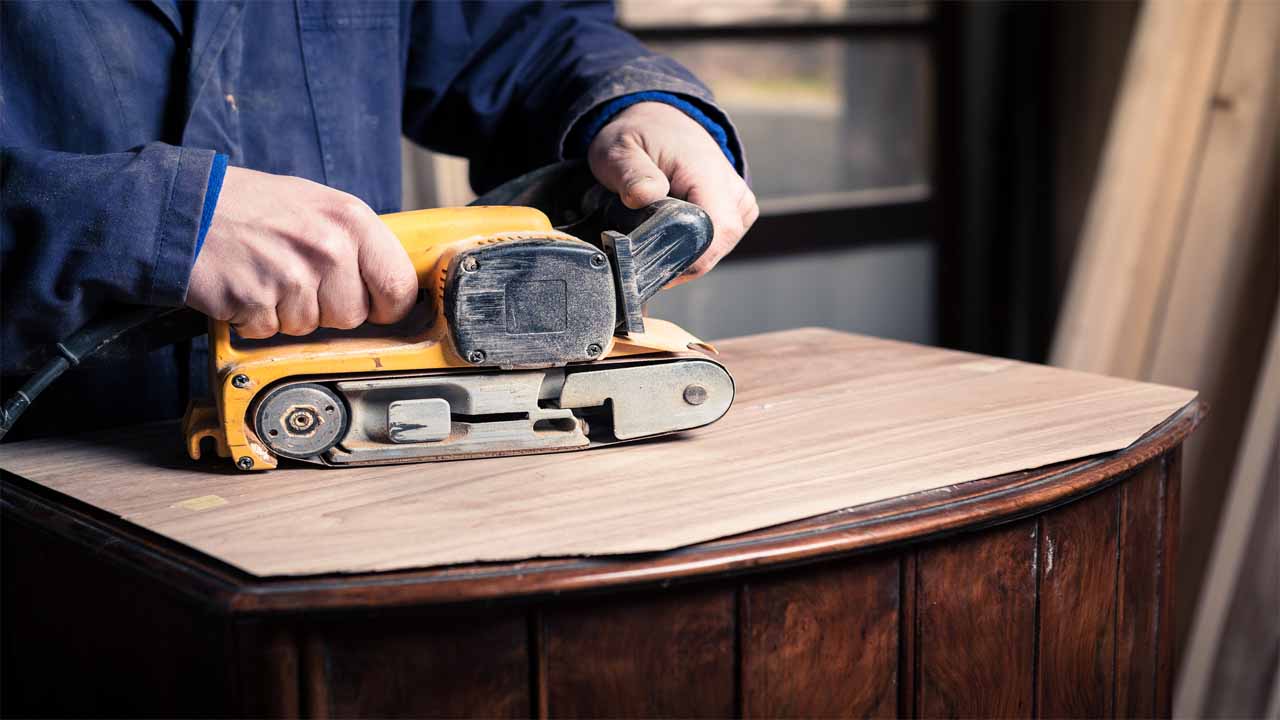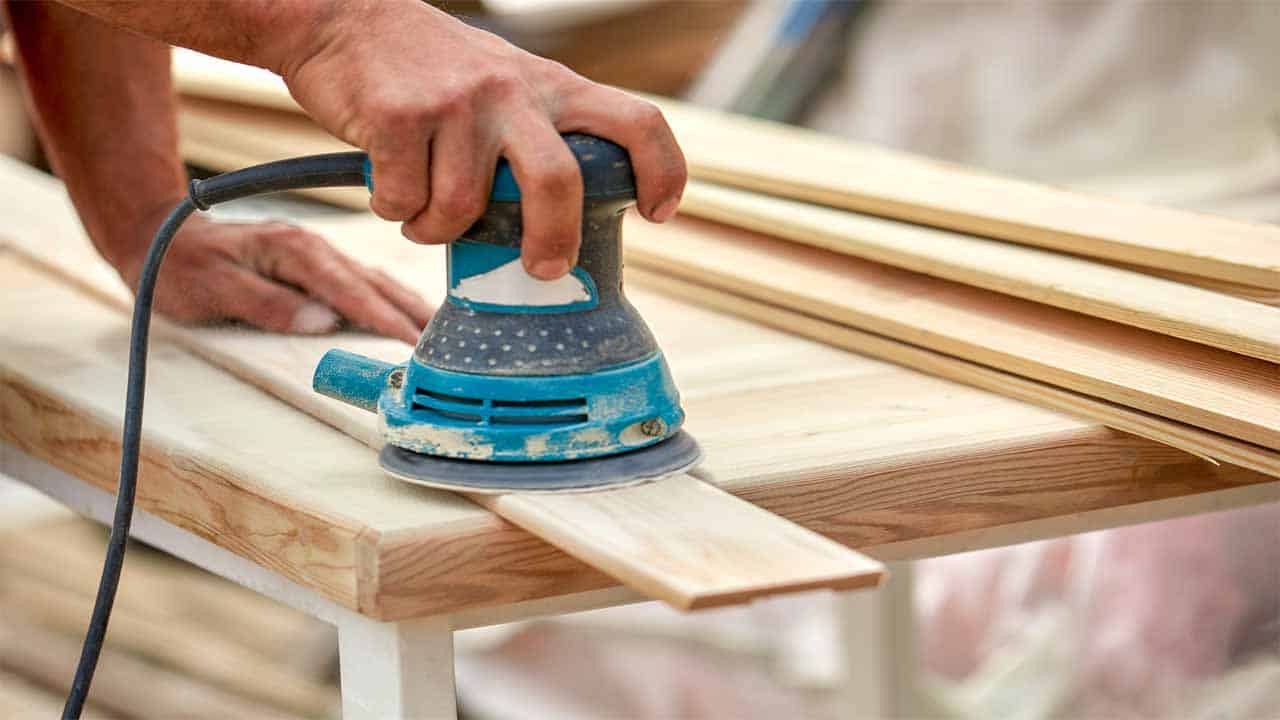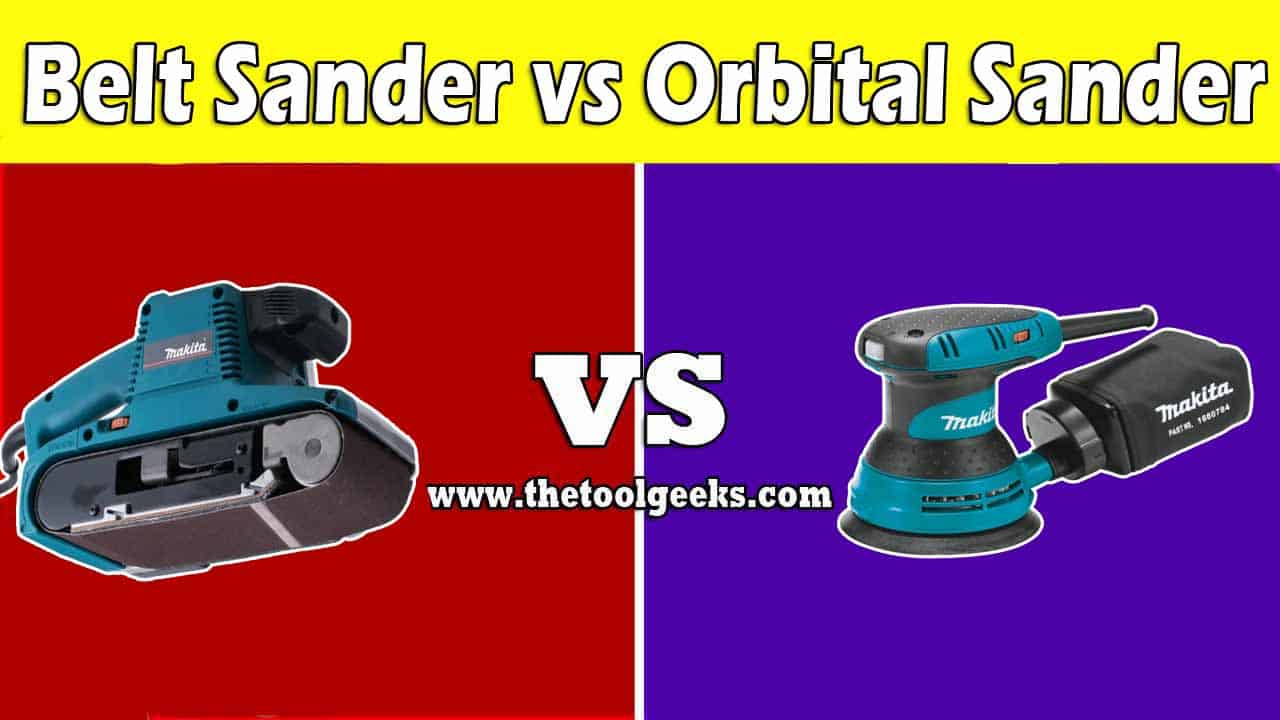Belt Sander vs Orbital Sander (5 Differences Explained)
TheToolGeeks.com is a participant in the Amazon Services LLC Associates Program and other affiliate advertising programs. We may earn from qualifying purchases. (Learn More).
Either you are working on a piece of furniture or you are renovating your home, one thing is certain, you will need to sand. In the woodworking world, sanding is just as important as cutting the wood you want to use.
Just like any other power tool, using a sander makes your sanding task easier, quicker, and it also gives you a better finish than if you sand manually. But then comes the concern of which sander you should get.
There are many sanders to choose from which can make your decision a bit confusing. Luckily, this post will identify two of the most common sanders used by both beginners and professionals. These are the belt sander and the orbital sander.
This post will compare the belt sander vs orbital sander and help you figure out which of the two you need for your task. So let’s get on with it.
First, let’s check out belt sanders.
Related Read — Palm vs Belt Sander
Jump To Page Contents:
What Is a Belt Sander and What Is It Used for?
The belt sander is a type of sander used primarily for prepping wood to be worked on. Belt sanders are very powerful and they can be used to strip different materials from wood easily.
Belt sanders are popular because of the power of the tool. The sander can tackle large sanding tasks and large wooden surfaces easier than virtually every other sander.

The speed and increased power of the belt sander make it possible to be able to strip off finishes and other materials from the wood in no time. Belt sanders use a sanding belt to sand surfaces. Unlike most sanders that use regular square-shaped or disc-shaped sandpaper, belt sanders use a flat loop-like sanding pad to sand different surfaces.
In terms of its use, belt sanders are more suitable for flat large surfaces like decks and floors. The sander due to its increased speed and power can cover large surfaces easily and in time too.
Though the belt sander is very powerful and fast, it is best reserved for professionals and large-scale tasks. Using this sander to sand small surfaces or leaving it in the hands of a beginner will result in poor sanding results. The belt sander will turn out difficult to control and this can gouge the wood being sanded.
However, if you are experienced with using this tool, then you will very much enjoy using the sander for your task. The biggest advantage of the belt sander is its power. Now, let’s check out orbital sanders.
Related Read — Best Belt Sanders
What Is an Orbital Sander and What Is It Used for?
Orbital sanders are also very popular sanders. The orbital sander is used by both beginners and professionals for sanding different surfaces.
Orbital sanders are particularly used for their finishing. The sander is gentler than belt sanders so you do not risk damaging the wood with this sander as much as you would with a belt sander.

Orbital sanders are not particularly powerful sanders. They are categorized as medium-power sanders. The orbital sander works by rotating the sanding pad in little circles or orbits making it easy to achieve a smoother finish. This is how the orbital sandpaper gets its name.
Orbital sanders also make it easy to get in corners and edges easily. The structure and design of the sander don’t allow it to cover large surfaces like other powerful sanders but what the orbital sander lacks in terms of power, makes up for it in terms of its finishing.
Now that we know what both sanders are and why they are used, let’s compare them and see which will be the best sander for your task.
Related Read — Best Random Orbital Sanders
Belt Sander vs Orbital Sander (Head to Head)
The orbital sander and the belt sander are both amazing power tools to have. However, when it comes to buying one, it is a good idea to know where both sanders stand when compared to each other. So let’s do a vivid comparison by using the features of both sanders.
The Power
The power of a sander determines how much material it can remove and how quickly it can remove the materials too. The belt sander is renowned for its impressive power. The belt sander is more powerful than not just the orbital sander but many other sanders too. The increased power of the belt sander makes it possible to remove large materials like finishes and even wood from a wooden surface.
Not only is the belt sander more powerful than the orbital sander, but it would also remove more materials quicker than the orbital sander. The belt sander is what you use on a rough piece of wood or log before other sanders like the orbital sander and palm sander can be used.
Using an orbital sander on a rough wooden surface wouldn’t do much sanding. You will most likely damage the orbital sander but if you have a belt sander, then you are good to go.
Belt sanders because of their power are more suited to large and rough wooden surfaces. However, you should exercise a little bit of caution. While the belt sander is a powerful sanding tool, you shouldn’t attempt using it unless you are experienced.
This is because it’s very easy to damage or gouge delicate wood with a belt sander if you aren’t experienced with using one. Let’s check out another feature.
The Finishing
Sanding is done for primarily one reason and this is to improve the finish of the wood and help the stain look cleaner after being applied. When it comes to finishing, the belt sander isn’t even in this contest.
Belt sanders are largely aggressive sanders and this is because of the sander’s power and increased speed. If you want to finish a wooden surface or smoothen it enough for staining later, a belt sander shouldn’t even be considered.
Orbital sanders on the other hand will do a good job in terms of finishing wooden surfaces. The orbital sander orbits the sanding pad across the surface making it easier to move the sander easily and achieve a smooth finish.
The sander is also great with edges and corners so if you want to sand your baseboard, stairs, or furniture for a new coat of finish, the orbital sander is your best bet. When you want to finish the wood, an orbital sander is what you use.
Versatility
Both sanders are great individually and they both can carry out different tasks. However, in terms of versatility, the orbital sander is a bit more versatile than the belt sander. Due to the rectangular shape of the orbital sander, it is easy to move the sander across a surface. It is also possible to sand corners and edges easily with an orbital sander as opposed to a belt sander.
Also, orbital sanders make it possible to sand tight areas like the underside of a table or a cabinet. This is because orbital sanders can work well in tight spaces and difficult angles. A belt sander doesn’t give you that luxury.
With a belt sander, you are more restricted to flat surfaces like tabletops and countertops. You can’t sand edges and corners with a belt sander because the sander isn’t that versatile.
If you are renovating your home or you are building furniture that will need a lot of sanding, then an orbital sander would be better because you will be tackling different sanding needs and different surfaces. The orbital sander will be better because it can do way more than the belt sander.
The Cost
Of course, cost matters when you want to buy a new power tool like a sander. In terms of price tags, belt sanders cost more than orbital sanders.
The reason for the increased price of the belt sander is because the sander is bigger, faster, and more powerful which means you can complete large-scale tasks in no time.
Though the belt sander can be a bit high priced, it’s still a very good investment so if you have the money, you can get one. Just be sure you get the best option.
A friendly reminder: the best option isn’t always the most expensive.
Related Read — Best Battery-Powered Sanders
The Size and Weight
No one likes a heavy sander. Using a heavy sander makes your work more tedious. In terms of weight and size, belt sanders weigh more than orbital sanders and they are bigger too.
Belt sanders can weigh as low as 8 pounds while the heavier models can weigh well over 16 pounds. On average, a belt sander weighs about 12 pounds which is still pretty fair in terms of weight.
Belt sanders are also bigger than orbital sanders. While most orbital sanders can be used with one hand, you will most likely need to hold your belt sander with both hands because of its size.
Orbital sanders weigh considerably less than the belt sander. Orbital sanders can weigh as low as 2 pounds while the bigger and heavier models will still weigh lower than 10 pounds. The lightest belt sander is usually about the same weight as the heaviest orbital sander.
Though it’s fair to say that some special orbital sanders can weigh about 15 pounds too. However, you wouldn’t find such in your regular woodworking shop. Such orbital sanders are usually found in industries and large wood construction companies.
Related Read — Orbital vs Palm Sanders
Should You Buy the Belt Sander or the Orbital Sander?
It all boils down to this question. Which of the two sanders should you buy? While the answer to this question ultimately depends on you, there are a few factors to consider before picking one. Let’s check out these factors.
Your Task
One of the biggest determinants of which sander you will get is the task you have at hand. The task includes the type of finish you aim to get and the type of wood you are working on.
If you are working on a very rough wooden surface, then a belt sander will work best because the belt sander is much more suited for rough surfaces than the orbital sander.
If your task also involves stripping off multiple layers or coats of finish from a wooden surface, then a belt sander will also work best because belt sanders can strip off more material than orbital sanders.
Belt sanders also work best on flat surfaces so if you want to sand a tabletop, a countertop, or a deck, then the belt sander is best.
However, if your task involves light sanding or you are working on a wooden surface with edges and tight corners, then the orbital sander will work best because orbital sanders can fit into tight corners and sand edges to near perfection.
Orbital sanders are also great for sanding wooden surfaces that will be stained later because they are finishing sanders. A good rule to remember is that belt sanders are more suited to rough tasks and plain surfaces while orbital sanders are more suited to wooden surfaces with edges and difficult angles.
Related Read — How to Sand Epoxy Resin?
The Cost
The amount you are willing to spend on a sander will determine which one you will get. The belt sander as stated earlier is more expensive than the orbital sander. So if you want a pocket-friendly option, you should go for the orbital sander.
If you want to cut down the cost of either sander, you can buy used sanders or second-hand sanders. Used sanders usually cost less than brand new ones.
Your Level of Experience
While both sanders are easy to use, the belt sander requires a higher level of experience to operate it. This is because the sander is aggressive and with its increased power and speed, anything can go wrong if you don’t know how to use the belt sander.
Orbital sanders on the other hand are lighter, smaller, and not as aggressive as belt sanders which means they are easier to use. If you are a beginner or you have no experience with using a sander, you should go for the orbital sander. Belt sanders should be left to the more experienced professionals.
So there you have it. If you have any questions or comments about the topic, please leave them below and I’ll try to answer them as soon as possible. Have a nice day.
Amazon and the Amazon logo are trademarks of Amazon.com, Inc, or its affiliates.

